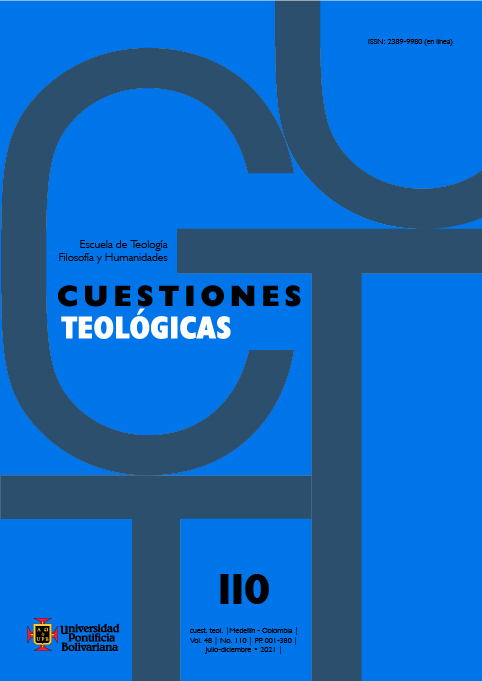Shiphrah and Puah: brave, rebellious and wise heroines. The figure and actions of midwives in Ex 1, 15-22
Main Article Content
Abstract
After the account of the beginnings of slavery suffered in Egypt, Ex 1: 15-22 narrates how two brave midwives, Shiphrah and Puah, moved by the fear of God, disobeyed the order to kill the newborn Hebrew males. Their intrepid and intelligent actions prevent infanticide and become a cause of blessing for the people and for themselves. These heroines embark on an unequal combat and defeat an all-powerful monarch who wants to destroy the People of God, and they become an example of the struggle against the culture of death and discarding. In a world that turns its back on immigrants and where ethnic cleansings and genocides still exist, they stand as prototypes of women of faith committed to the sufferings of the poor and the excluded. Remarkably, the biblical tradition did not recall their valiant epic; on the contrary, rabbinical tradition and Hebrew legends did. This article aims to recover the figures of Shiphrah and Puah, by carefully studying different aspects of these exceptional women, such as the office of midwife in ancient times, the possession of names, the question of their nationality, the reckless actions they carried out, the fear of God and the wisdom they possessed, their transformation into instruments of Providence, the blessing obtained, their cunning and courage, motherhood, resistance to oppression, their sisterhood, etc. For the analysis, different instances of the critical historical method, narratology, rabbinic interpretation and other approaches will be applied.
References
Agua Pérez, A. del. (1985). El método midrásico y la exégesis del Nuevo Testamento. Institución San Jerónimo para la Investigación Bíblica.
Alonso Schökel, L. (1994). Diccionario bíblico hebreo-español. Trotta.
Andiñach, P. R. (2006). El Libro del Éxodo. Sígueme.
Arana, M. J. (2006). Mujeres y espiritualidad de la resistencia. En P. de Miguel Fernández (ed.), Espiritualidad y fortaleza femenina (pp. 79-124). Desclée de Brouwer.
Barnawi, N., Richter, S. y Habib, F. (2013). Midwifery and midwives: A historical analysis. Journal of Research in Nursing and Midwifery, 2(8), 114-121.
Barroso, A. (2006). Mujeres, resistencia y vida cotidiana. En P. de Miguel Fernández (ed.), Espiritualidad y fortaleza femenina (pp. 165-200). Desclée de Brouwer.
Calés, M. (dir.) (2004). El talmud de Babilonia: Tratados Nazir-Sota. Acervo Cultural.
Cassuto, U. (1967). A commentary on the book of Exodus. Magnes Press.
Childs, B. S. (1965). The birth of Moses. Journal of Biblical Literature, 84(2), 109-122. https://doi.org/10.2307/3264132
Childs, B. S. (2000). El libro del Éxodo. Verbo Divino.
Ebeling, J. R. (2010). Women’s lives in biblical times. T&T Clark.
Exum, J. C. (1983). “You shall let every daughter live”: A study of exodus 1: 8-2: 10. Semeia, 28, 63-82.
Flavio Josefo. (1961). Obras completas. Vol. 1: Vida. Antigüedades judías. Libros I-VI. Acervo Cultural.
García Bachmann, M. (1999). ¿Qué hacían mientras tanto las mujeres hebreas (Éxodo 1-2)? Cuaderno de Teología, 18, 7-19.
Ginzberg, L. (1980). The Legends of the Jews. The Jewish Publication Society of America.
Girón Blanc, L. F. (1989). Midrás Éxodo Rabbah (vol. 1). Institución San Jerónimo para la Investigación Bíblica.
Hasan, I., Zulkifle, M., Ansari, A. H., Sherwani, A. M. K. y Shakir, M. (2011). History of ancient egyptian obstetrics & gynecology: A review. Journal of Microbiology and Biotechnology Research, 1(1) 35-39.
Henao, J. A. (2011). El actuar yahvista de las mujeres de Egipto. Cuestiones Teológicas, 38(90), 377-400. http://www.scielo.org.co/scielo.php?script=sci_arttext&pid=S0120-131X2011000200008
Janssen, R. (2018). A new reading of shiphrah and puah: Recovering their voices. Feminist Theology, 27(1), 9-25. https://doi.org/10.1177/0966735018789129
Johnson, E. A. (2009). La que es: El misterio de Dios en el discurso teológico feminista. Herder.
Langston, S. M. (2006). Exodus through the Centuries. Blackwell. https://doi.org/10.1002/9780470773604
Lattus, J. y Carreño, E. (2010). El asiento del nacimiento. Revista de Obstetricia y Ginecología Hospital Santiago Oriente Dr. Luis Tisné Brousse, 5(1) 41-50.
León Azcárate, J. L. de. (2011) “Yo soy Yahvé, el que te sana” (Ex 15, 26): Enfermedad y salud en la Torá”. Theologica Xaveriana, 61(171), 65-96.
Leon-Dufour, X. (1990). Vocabulario de teología bíblica. Herder.
Martínez Saiz, T. y Pérez Fernández, M. (2011). Traducciones arameas de la Biblia: Los targumin del Pentateuco. Verbo Divino.
McGeough, K. (2006). Birth bricks, potter’s wheels, and exodus 1, 16. Biblica, 87(3) 305-318.
Morschauser, S. (2003). Potters’ wheels and pregnancies: A note on exodus 1: 16. Journal of Biblical Literature, 122(4), 731-733. https://doi.org/10.2307/3268074
Ndjerareou, A. (2010). Êxodo. En T. Adeyemo (ed.), Comentario biblico africano (pp. 87-130). Mundo Cristão.
Pixley, J. (2010). Liberation criticism. En T. B. Dozeman (ed.). Methods for Exodus (pp. 131-162). Cambridge University Press. https://doi.org/10.1017/CBO9780511811142.006
Pontificia Commissio pro Nova Vulgata Bibliorum (1979). Nova Vulgata Bibliorum Sacrorum. Libreria Editrice Vaticana.
Porcile Santiso, M. T. (2008). Con ojos de mujer: Lo femenino en la teología y en la espiritualidad contemporánea. Claretiana.
Real Academia Española. (2014). Diccionario de la lengua española. Espasa-Calpe.
Römer, T. (2015). Moses and the Women in Exodus 1-4. Indian Theological Studies, 52(3), 237-250.
Roth, A. M. y Roehrig, C. H. (2002). Magical bricks and the bricks of birth. The Journal of Egyptian Archaeology, 88(1), 121-139. https://doi.org/10.1177/030751330208800109
Sheriffs, D. (1990). Moving on with God: Key motifs in Exodus 13-20. Themelios, 15(2), 1-2. http://www.gospelstudies.org.uk/biblicalstudies/pdf/themelios/exodus_sheriffs.pdf
Siebert-Hommes, J. (2010). Las salvadoras del liberador de Israel: Doce “hijas” en Éxodo 1 y 2. En M. Navarro e I. Fische Puerto (eds.), La Torah (pp. 305-321). Verbo Divino.
Ska, J. L. (2006). Il diritto e la legge: Una distinzione fondamentale nella Bibbia. La civiltà cattolica, 157(3737), 468-479.
Töpfer, S. (2014). The physical activity of parturition in ancient Egypt: Textual and epigraphical sources. Dynamis, 34(2), 317-335. https://doi.org/10.4321/S0211-95362014000200003
Vaux, R. de. (1974). Historia antigua de Israel. Vol. 1: Desde los orígenes a la entrada de Canaan. Cristiandad.
Weems, R. J. (1992). The hebrew women are not like the egyptian women: The ideology of race, gender and sexual reproduction in Exodus 1. Semeia, 59, 25-34.
Wicke, D. W. (1982). The literary structure of Exodus 1: 2-2: 10. Journal for the Study of the Old Testament, 7(24), 99-107. https://doi.org/10.1177/030908928200702407






